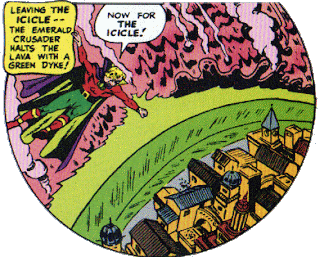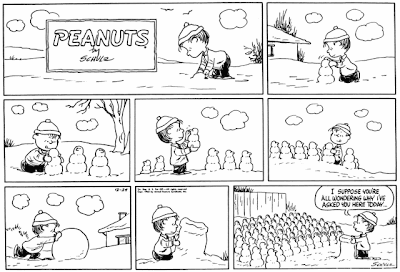Martin Nodell came to New York City from Philadelphia in the late 1930s with hopes of becoming an actor. He soon found out that his calling was not in the theatrical arts, but in graphic art. He got freelance work with comic book publishers, and hoped to eventually move into the more lucrative field of advertising.
In 1939, after doing a few humor-strip assignments for All-American (later DC) Comics, he asked editor Sheldon Mayer if he could get more steady work. Superman had debuted a year earlier in Action Comics, and had been a surprise hit. Mayer told Nodell that if he could come up with an original superhero character to rival Superman, then he could have a regular job drawing it.

On his commute home to Brooklyn, Nodell gave the matter much consideration. He was familiar with classical myths and legends, and wondered if he could use them as the basis for a modern-day hero. As he waited on the subway platform for his delayed train, he observed a worker on the tracks waving a red lantern, signaling to the conductor of the approaching train that there was some sort of obstruction on the tracks. After the problem was resolved, the worker waved a green lantern to indicate that all is safe.
The green lantern -- a sign that all is safe.
The green lantern. Nodell liked the sound of those words. It brought to mind the story of Aladdin from
1,001 Arabian Nights -- the boy who had a magic lamp and a magic ring which put powerful genies at his command. The more he thought about it, the more he liked it.
Nodell wrote an origin story for his new character, and drew up some sample pages that he brought to Mayer. Mayer found the artwork a little rough, but thought the concept was a powerful one. He partnered Nodell with
Batman writer Bill Finger, and together they reworked the story. Nodell, inspired by Aladdin, had named his hero "Alan Ladd." Finger thought this sounded too contrived, and changed the last name to "Scott." Neither of them realized at the time that there was a character actor named Alan Ladd who would become a big name in Hollywood in a couple of years.
The story told of Alan Scott, a young engineer who was the only survivor of a train crash when a bridge built by Alan's construction company collapsed. Alan was certain that the accident was an act of sabotage by a rival company, but had no proof. Absent-mindedly clutching a green train lantern, Alan felt faint and passed out, as the lantern began to glow brightly.
Alan then had a dream of a meteorite that crashed in ancient China and burned with a green flame, and a voice that spoke a prophecy of bringing death, life, and power. When the meteorite cooled, an old lamp maker forged an oil lamp from its metal. An angry mob, frightened that the lamp contained an evil power, killed the lamp maker and wrecked his shop. But the lamp glowed with a bright green flame, killing the mob and enacting first part of the prophecy.

The lamp passed through many hands, until it was found in a junk heap near a mental hospital. It was given to one of the patients, who had suffered a nervous breakdown and enjoyed doing metalwork as therapy. He reshaped the beaten old lamp into a modern railroad lantern. When he finished, the lantern flamed green once again, restoring the patient's sanity and giving him a new life. The second part of the prophecy had been fulfilled.
Now, a voice from the lantern told Alan, it was time for the third and final part of the prophecy to be realized. The lantern told Alan to make a ring from part of its metal. By touching the ring to the lantern once every 24 hours, he would have the power that was promised centuries ago. Alan did as he was told. With his newfound power ring, he forced a confession from the saboteurs, who thought him to be a ghost.
Realizing that he could do much good, he made himself a costume "so bizarre that once I am seen I will never be forgotten" and spoke a solemn vow:
“And I shall shed my light over dark evil, for the dark things cannot stand the light… the light of the Green Lantern!”
Bizarre certainly was the word for Alan’s costume: a red puffy-sleeved shirt with a green-and-yellow lantern insignia on the chest, green tights, red boots, a wide brown leather belt, purple mask, and a high-collared purple cape with a light green lining. Clearly, fashion sense was not one of his powers.

But the powers he did have were many and varied. The green beam of the power ring enabled Green Lantern to fly, pass through walls, hypnotize people, melt steel, transmute matter (like turning guns into glass, or bullets into candy), and made him immune to metals. This last power was a clever addition on Finger’s part. It allowed Green Lantern to shrug off bullets and knives, but still made it possible for him to engage in down-and-dirty brawls. A wooden chair or ceramic vase could still knock him for a loop. Over the next several years, the “immunity to metals” gradually changed, so that by the mid-forties, his power beam had no effect on anything made of wood. His powers also evolved, and after the first few years, Alan had learned to use his power ring to form objects out of solid light, which responded to his will.
The first Green Lantern story appeared in
All-American Comics #16, with the date of July 1940 on the cover. He appeared every month in
All-American Comics, and proved popular enough to become a regular feature in
Comics Cavalcade and as a member of the Justice Society of America in
All-Star Comics. He soon earned his own magazine,
Green Lantern Quarterly, the fourth of only five DC superheroes in the 1940s to have a self-titled comic book. With issue #19 in 1946, the
Green Lantern magazine changed from quarterly to bimonthly.

Alan Scott became an engineer for Apex Broadcasting in
All-American #20, and was so charismatic that the station owner made him a radio announcer in
Green Lantern Quarterly #2. He lived in Gotham City, just like Batman, though he never did cross paths with the Caped Crusader or any of his colorful villains. Green Lantern had his own rogues gallery, though, including the Sportsmaster; the Gambler; the immortal Vandal Savage; the Icicle; swamp monster Solomon Grundy, whose plant-like nature made him immune to the power ring; and the Harlequin, a woman who never actually committed any crimes, but built up a criminal reputation to attract the attention of the Green Lantern, the only man she considered her equal.

Green Lantern also picked up a sidekick: Doiby Dickles, a tough but dimwitted cab driver with a thick “Joisey” accent. Doiby (don’t call him “Derby” unless you want a black eye), who accidentally discovered Alan’s secret identity and helped him protect it, was based on character actor Ed Brophy. Doiby, with his beloved taxi, Goitrude (originally Esmeralda) was Alan Scott's unofficial chauffeur, and carried a green flare pistol to summon Green Lantern when an emergency arose.
Originally, Alan recharged his ring either silently or while reciting the oath mentioned above. In 1942, there must have been a communication breakdown among the writers, because during that year Alan spoke no fewer than six different oaths in various stories:
"Let the light of the lantern penetrate the dark places of ignorance and wrong,
setting all minds right and overthrowing all servants of evil!"
"I shed my light upon the darkness!
Evil has no place to hide itself!
Green Lantern goes forth to conquer!"
"My rays strike the darkest corner,
Banishing all wickedness!"
"Let all power and triumph be mine in whatever right I do!"
"The light of the Green Lantern pierces darkness and mystery,
And its radiance will strike at the heart of evil!"
"As the green rays strike forth into darkness,
So may all black evil be exposed and driven away!"
In the fall of 1943, when noted science fiction author Alfred Bester became the regular writer of the
Green Lantern series, the oath took the form that has lasted practically unchanged to the present day:
"In brightest day, in darkest night,
No evil shall escape my sight.
Let those who worship evil's might
Beware my power,
Green Lantern's light!"
This oath first appeared in
Comic Cavalcade #4,
All-American #53, and
Green Lantern #9, all of which came out about the same month, making it hard to determine which was first. A few months later, the word “darkest” was changed to “blackest.” Though Bester is usually credited with creating this oath, he stated in an interview at the 1979 World Science Fiction Convention that it was already being used before he began writing
Green Lantern.

By the late forties, the popularity of superheroes had waned. Readers were turning toward Western, war comics, horror, science fiction, and, notably, animal stories. Green Lantern acquired a pet: Streak the Wonder Dog, who soon became the star of the stories. Streak even upstaged his master on several covers shortly before the series was cancelled. This was not the end of Green Lantern, though, as we’ll see in the next chapter.

And what of Green Lantern’s creator Martin Nodell? In 1947, he left DC to work for Timely Comics on features including Captain America and the Human Torch. Not long after that, he left comic books for the advertising field, and in the 1960s created another iconic character which for many years was even more famous than GL: Poppin’ Fresh, the Pillsbury Doughboy. Nodell passed away in December, 2006, at the age of 91.
(Click here for the next chapter.)














































